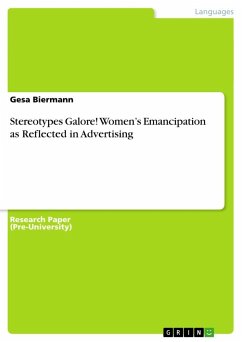Pre-University Paper from the year 2009 in the subject Didactics for the subject English - Miscellaneous, grade: 1,0, Maria-Ward-Gymnasium Augsburg, language: English, abstract: A woman rushes across the screen, cleaning the floor with the latest "turbo power 3" multifunction vacuum cleaner, feeds her baby with the new and improved baby formula and marvels at her almost blindingly clean dishes, then turns to the camera with a smile on her face that suggests she could not imagine a more satisfying life. This description might sound a little old fashioned and restricting, but it is commonly conveyed to us through advertising, even today. Is this truly the concept we have of modern women? Has not the women's movement brought about more change than just in legal status? As advertising is one of the most powerful educational mediums in modern society, the image of women it conveys is not only quite interesting, but also of great importance. There is such an overload of advertising surrounding us; we're bombarded daily with a vast amount on the radio, TV, online, on billboards, in magazines, even on the most common things like a pen-there is no way to escape its influence. Advertising's key objective is making money; selling an image of perfection to consumers makes great business sense, because it sends people on a never-ending quest, trying to achieve the impossible, all the while spending endless amounts of money. Advertising does not only sell a product, but, through stereotyped characters, also provides us with an exemplary way of life. The concepts of beauty, love, and normalcy it promotes, might have changed in the course of 40 years, but the central message remains the same, "you have to buy this or otherwise you will be unacceptable". It seems that in the 21st century, women's emancipation is an issue that should long since have been checked off the list as accomplished. The great effect of the feminist movement, with better educated, working women, participating in every aspect of life, is undeniable, yet the influence it has had on advertising's portrayal of women remains questionable. Have stereotypes been banished, did they evolved or maybe even stay the same? The focus is on the 1950s and the 1990s as representative decades for the pre-and post-feminist attitudes, in order to explore the truth of advertising and finally be able to answer the question: does advertising's image of women match their place in society?
Hinweis: Dieser Artikel kann nur an eine deutsche Lieferadresse ausgeliefert werden.
Hinweis: Dieser Artikel kann nur an eine deutsche Lieferadresse ausgeliefert werden.








